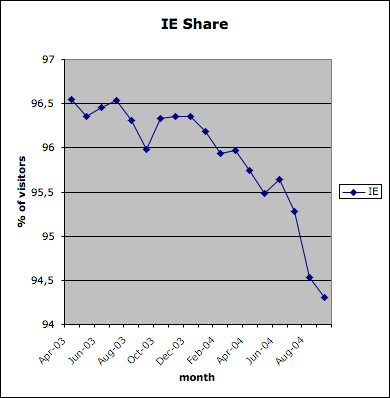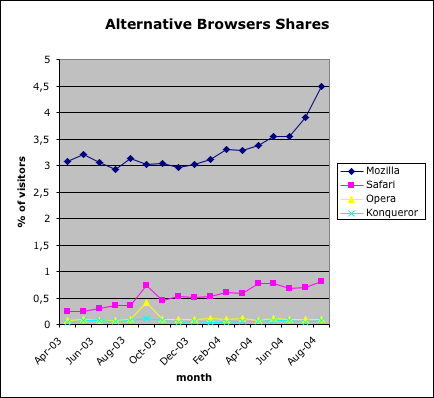Browsers War II: observing trends
(For a little insight on this post, I invite you to read Towards Browsers War II.)
Technographics, or the statistics about the technologies used to access a web site, are part of the metrics that every webmaster should follow on a regular basis. Typical technographics include browsers and operating systems, as well as screen sizes and client-side technologies (such as plug-ins, cookies, javascript, java, etc.).
There has been a recent surge of reports that the market share of Internet Explorer is falling while those of alternative browsers such as Mozilla, Firefox or Safari are rising. According to WebSideStory (as reported by Linux World AU and Silicon.com) which aggregates statistics from 25 million unique browsers through its outfit StatMarket, IE's market share has slowly dropped from 95.73 percent on June 4 to 94.73 percent on July 6, while Mozilla and Netscape's combined market share has increased by 26 percent, rising from 3.21 percent of the market in June to 4.05 percent in July. According to WebSideStory, this is the first time such downward trend appears since they started measuring in 1999.
Personally, I started to observe something in January 2004 on Capgemini's main site that I think is worth sharing with my peers.
The following figures show the evolution of the market shares of the top five browsers -- respectively, Internet Explorer, the Mozilla family, Safari, Opera and Konqueror (aggregated by versions and platforms) -- used by the visitors of www.capgemini.com between April 2003 and September 2004:


| Browser | April 03 | Sept 04 | Evolution |
| IE | 96.55% | 94.31% | -2.32% |
| Mozilla et al. | 3.08% | 4.66% | 51.30% |
| Safari | 0.25% | 0.94% | 276% |
| Opera | 0.08% | 0.08% | N/S |
| Konqueror | 0.03% | 0.06% | N/S |
Taking out a discrepancy in Sept 2003 (the spike for Safari seems to coincide with the release of Safari 1.1, not sure about the spike for Opera though), one can observe, starting around January 2004, a clear and increasing fall in IE's share with a simultaneous and accelerating increase for the Mozilla family plus a rather constant increase for Safari. I think I can reasonably infer that there is a real trend installed here and that the share of IE is being eroded mostly by Mozilla and, to a lesser extent, by Safari. The fact that this trend comes six months before WebSideStory starts seeing it on its broad base may be related to the technical nature of this site's audience, people who are bigger users of IT technologies than the average business user, more exposed therefore more sensitive to security risks, and probably more informed and open to alternatives. Among those people are also many influencers who can (and surely do) play a significant role to spread the word about those alternatives. However it should be noted that those visitors using their company computer usually have little to no influence on their "standard" set of software, which normally increases inertia and traditionally plays in favor of Microsoft (so this fact goes, intuitively, against the observable trend).
As I wrote before, statistics taken from a single web site should be taken with a grain of salt, especially the percentages above, as they relate only to the specific audience of this site. It is therefore important to put things in context, which is for this site:
- Type of site and market
- Corporate site, business-to-business, IT consulting/technology/outsourcing services
- Audience
- Clients, prospects, job seekers, analysts, journalists, shareholders, members of the company -- mostly business people with a majority of technical/computer-savvy profiles. International audience coming from all over the world
- Top 4 Operating Systems (all versions)
- Windows: 97.6%, Linux: 1.73%, Mac OS: 0.46%, Sun OS: 0.11% -- the market shares of OSs has remained quite stable during the same period, and therefore should not have had any significant influence on the change of browser
As a web manager I would like to see more stats from peers published on the web. It's one thing to hear the buzz on how great your life will be if you use web standards and forget about browsers, it's another to actually back up this idea with figures. That's why I'm doing this and I welcome links to similar stats (please add them in the comments or trackback this entry).